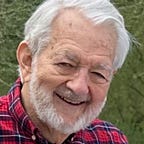Catherine Gasich, Orchardist
A Vignette Based on the Book, Charged Bodies
The 40th Anniversary edition of my book, CHARGED BODIES. PEOPLE, POWER AND PARADOXES THAT LAUNCHED SILICON VALLEY, was released in April 2024. It profiles twenty-five people who, in their own words, describe the transition of the Santa Clara Valley, south of San Francisco, from an agricultural heartland to the birthplace of the digital revolution in less than half a century.
I interviewed Catherine Gasich in March 1983, at her home located on a residential lane in the foothills of the Santa Cruz Mountains.
She had been, from 1935 until 1963, the postmistress of Cupertino. Born in 1900, she and her family moved to the South Bay soon thereafter and experienced the 1906 San Francisco earthquake, the Great Depression, and the industrial explosion in the valley.
The apricot blossoms were pretty little apple-like blossoms, pinkish in color. But the prunes, when they bloomed the whole valley was snow-white, and then this beautiful perfume would come towards you . . . it was just beautiful. We used to have Blossom Festival Days in the olden days, usually in mid-March, which were held in Saratoga. People from all around the Bay Area came to our valley to enjoy them.
Land was cheap, but nobody had any money. There were some wealthy people, but most of the orchards were, I’d say, fifty, sixty or seventy acres. Some were ten acres or less.
During the war, the Valley grew much of the produce that fed the boys racing island to island to bring the War in the Pacific to a close.
And when the war was over, the financial boom came to an end. The produce market tightened up and the Santa Clara Valley fell back into an economic slump.
So a program was launched to encourage industrial growth there. Promoters then started calling the area “The Valley of the Heart’s Delight.”
And during and after the war, the subdivisions started coming in.
I think it was a transition that just kind of happened. There was a little bit of electronics, mostly around Palo Alto. But it wasn’t like it is today. Mostly radio and things like that. It was much different. But little by little it just developed.
The Valley had an ideal climate, access to an incomparable variety of nearby “getaway”’ locations, and a university that was craving to establish its place in the sun. Just the attractions for companies that would depend on brainpower as the primary raw material.
And the upshot of it all was this: the industry that would soon transform Santa Clara was not back East after all, waiting to be lured out here. On the contrary, it was forming here all along — in a leaky attic laboratory at Stanford where a young Mr Hewlett and Mr Packard studied together; in garages out behind the fruit trees, and in an almost unbelievable assemblage of young people, tinkering, wondering, investigating, and kicking around on dusty country lanes between Palo Alto and San Jose.
If you enjoyed this story, you will love Charged Bodies by Thomas Mahon. Pick up the ebook directly from The Pragmatic Bookshelf.
If you prefer a print copy, please visit bookshop.org, where funds from your purchase go directly to a local bookstore of your choice.
